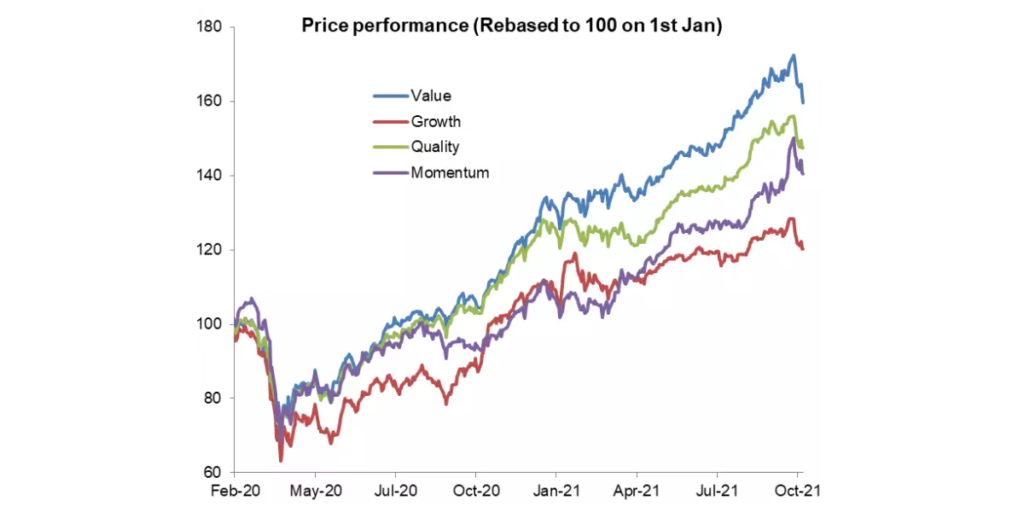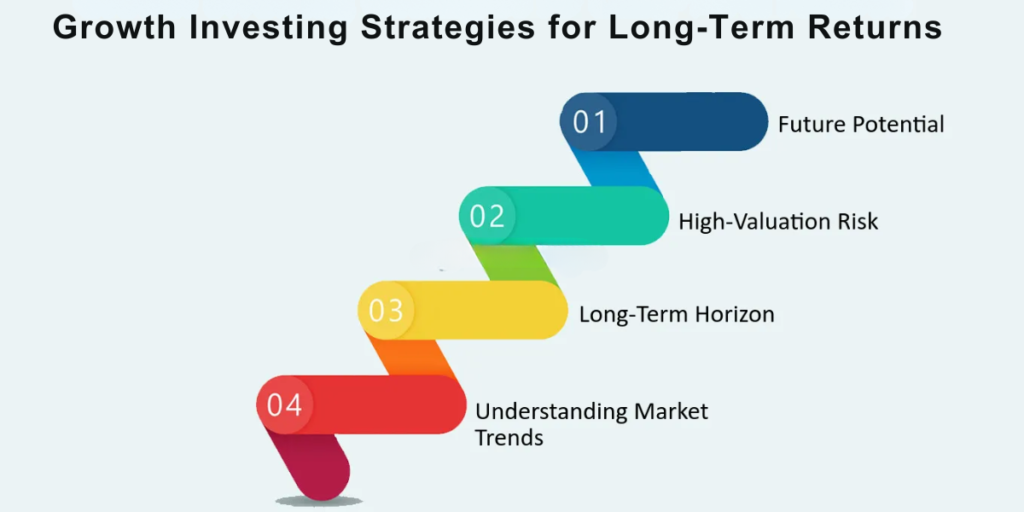Stock trading incorporates a number of strategies which investors pursue in building their wealth. Growth investing is one of such strategies. Unlike value investing, whereby investors are more interested in finding those stocks that happen to be undervalued, growth investing involves the finding of a firm that may grow faster than the average market. That can be a very rewarding strategy if the right stocks have been selected, but it also comes with its own kinds of risks. In this blog, we will discuss in detail growth investing-from what it is down to how you could get started with using it on your trading portfolio.
Table of Contents
1. What is Growth Investing?
Growth investment is that type of investment that caters to the growth of capital for an investor. Growth investors look for companies that have more than average growth potential in their respective sectors or the overall market. Such firms normally invest their earnings back into their businesses for further expansion, product development, or market penetration.
Whereas value investing is the search for undervalued stocks that trade beneath their intrinsic value, growth investing has to do with pinpointing those companies that could greatly grow their revenues, earnings, and market share in the future. Consequently, this would see the stock price increase greatly and thus lead to big profits for the investors.
2. Key Characteristics of Growth Stocks

The next best thing to knowing growth investing better is to know what constitutes a growth stock. Following are some common characteristics of growth stocks:
A. High Revenue and Earnings Growth
Growth stocks typically denote a high revenue and earnings growth. Most of these companies are growing very rapidly because their respective products, services, or technology have given them an advantage over their competitors. In this case, the investors pay a premium valuation for these stocks because they believe that the companies will continue to grow at an above-average rate in the future.
B. Reinvestment of Profits
Growth companies are the ones that, rather than distributing dividends to their proprietors or shareholders, plough the profits back into the company. This is to finance further growth ventures such as research and development, marketing, and venturing into new territories. For growth investors, the focus is on capital appreciation rather than income from dividends.
C. Higher Price-to-Earnings Ratios
Growth stocks have higher P/E ratios than value stocks, since investors are prepared to invest more in the future earnings of such companies. A high P/E ratio indicates that the market believes the company will achieve a high growth rate, even if it may not be profitable yet or if its current earnings are lower when compared against its stock price.
D. Market Leaders or Innovators
Many growth stocks represent leading companies in their respective fields or firms that disrupt the markets by their innovative ideas and products. Most of the time, such companies enjoy strong branding, have a loyal customer base, and show clarity in their vision pertaining to growth in the times to come. Typical examples include technology giants like Apple, Amazon, and Tesla that have shown, time and again, their capability to grow and capture market share.
Read More:- Value Investing : A Simple Guide to Building Wealth
3. The Fundamentals of Growth Investing
As mentioned earlier, growth stocks are those securities that yield a higher return as compared to the average market. Now, let’s discuss some of the fundamentals of growth investing and how you can apply the technique in your portfolio.
A. Identify High-Growth Sectors
Growth investing can be successful if one targets sectors that promise growth. Such examples include technology, healthcare, renewable energy, and e-commerce; in fact, these have had tremendous growth over the last few years. When targeting high-growth sectors, your chances of landing companies that guarantee substantial returns are increased.
B. Research Company Fundamentals
As much as one considers the potential in growth investment, it doesn’t mean that an investor can totally forget about the fundamentals. Search for companies with high revenue growth and expanding profit margins. The same way an increase in market share should give an indication of how well a company is performing up against the competition. Pay attention also to the management team of a company and experience in the strategy carriage for their growth.
C. Consider the Market Position
Is it a market leader, or is the company an industry disruptor? Leading companies with competitive positions, innovative products, and extremely loyal customers have more chances of continuing their growth in the long run. Understanding a company’s competitive advantage and how it intends to sustain those advantages is extremely important to growth investors.
D. Analyze the Company’s Financial Health
Though growth companies often invest their earnings back into the business, a strong bottom line is still nice to see. Debt spiraling out of control or negative cash flow does not tend to be very encouraging. Instead, you want to look for a company with a strong balance sheet, reasonable debt levels, and a lot of cash available to fund its growth initiatives.
4. How to Value Growth Stocks

Growth stock valuation encompasses both quantitative and qualitative analyses. The following steps represent the process to identify growth stocks:
A. Consistent Revenue Growth
One important indicator of a growth stock is sustained revenue growth. Thus, look for companies that have shown increased sales over several quarters or years. Consistent growth in revenues normally shows that the products or services of the company are in demand, and it has a model that can be scaled up.
B. Earnings Growth and Profit Margins
Look for earnings growth next, as one of the key factors to examine in a growth stock. These will be companies whose earnings have grown and show signs of further accelerating. It is always a good indicator of potential huge stock price appreciation. This is also where profit margins come in, as an expanding margin shows that a company is growing more efficient and profitable.
C. Check the Price-to-Earnings Growth Ratio
It is very useful for assessing growth stocks. This takes the P/E ratio and then divides by the company’s earnings growth rate. A PEG below 1 might mean that a stock is undervalued compared to its growth perspective, whereas if the PEG is over 1, the stock could be overvalued. Remember, the PEG ratio is but one metric and must be used in concert with other analyses.
D. Project the Future Growth Potential of the Company
While past performance is important, growth investing essentially involves the future. Evaluate the growth potential of the company considering its pipeline of products, market opportunities, and strategic initiatives. Is the company expanding into new markets or introducing new products? What is its blueprint for growth? Essentially, understanding the company’s future growth drivers is critical in making intelligent investment decisions.
Read More:- How to Use Stop-Loss Orders to Protect Your Investments
5. Common Risks of Growth Investing
While growth investing can offer substantial rewards, it is not without its risks. Here are some common ones to be aware of:
A. High Valuations
Growth stocks often trade at stretched valuations given their high growth prospects. Due to this reason, these are more vulnerable to market corrections and changes in investor sentiment. Valuation for a growth stock, if stretched too much, highly becomes vulnerable to a sharp price decline in case of any failure to meet growth expectations.
B. Market Volatility
Growth stocks might be a lot more volatile than other types of stocks, particularly in periods of turmoil or an economic decline. In fact, it is normal for investors to feel a bit jittery about the capability of the company to sustain this growth, which causes violent price fluctuations. The important thing a growth investor should do is be prepared for such volatility and maintain their eyes on the prize-the long-term growth potential of their investments.
C. Dependence on Continued Growth
Growth stocks often get priced on the expectations of continued rapid growth. When a firm fails to deliver, its stock takes a considerable beating. This could make growth investing a high-risk strategy, especially for firms in an extremely competitive or rapidly changing industry.
6. How to Succeed at Growth Investing

Though there are risks, with the right approach, growth investing can be a very rewarding strategy. Here are some strategies to help you succeed as a growth investor.
A. Diversify Your Portfolio
Any investment plan has to be diversified in nature to manage the associated risks, and it is no different in the case of growth investing. You can minimize the damage to your portfolio if one of the stocks in your portfolio doesn’t turn out as well as you expected, provided you have a well-diversified portfolio across sectors and companies. You may consider large-cap growth stocks, usually stable, along with small-cap growth stocks with higher growth but volatile in nature.
B. Quality
Not all growth stocks are created equal, of course. Your focus should be on companies with sound fundamentals, competitive advantages, and a clear growth strategy. It is these high-quality growth stocks that will most likely extend their growth in the long term and create returns on a sustainable basis.
C. Stay Ahead
Growth investing demands the ability to continually stay up-to-date about market trends, events within industries, and companies’ news periodically. Re-assess your investments and shift the portfolio as needed. A watch on economic indicators, interest rates, and other macroeconomic factors will also provide you with an indication of when growth stocks might face difficulty.
D. Be Patient
Growth investing is a long-term strategy. While it may be highly tempting to take your profits after a stock has done particularly well, the real potential of growth stocks often doesn’t really surface for years to come. Be patient and give your investments time to grow. Remember, investing is a marathon, not a sprint.
Conclusion
Growth investing is an exciting, dynamic strategy that offers considerable rewards to investors willing to accept the risks. Concentrate on the companies that have very good growth potential, powerful fundamentals, and innovative products or services that can, with time, offer a shot at substantial returns. Just be disciplined, research well, and expect volatility. If your frame of mind and approach are appropriate, growth investing can be one of the most valuable tools in the process of building wealth and achieving your financial goals. Happy investing!
